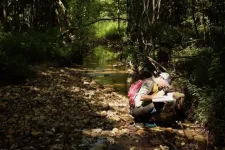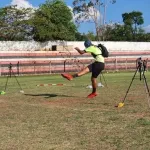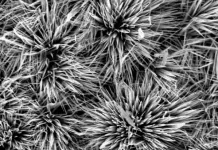Abundant and stable rocks are critical egg-laying habitat for insects in restored streams
2021-03-17
(Press-News.org) The abundance and other characteristics of rocks partially extending above the water surface could be important for improving the recovery of aquatic insect populations in restored streams.
Nearly three quarters of stream insects reproduce on large rocks that sit above the water surface by crawling underneath to attach their eggs. Increasing the number of large and stable emergent rocks in streams could provide more egg-laying habitat and allow insects to quickly repopulate restored streams.
"We found that restored streams had fewer emergent rocks for egg-laying and fewer total eggs than naturally intact streams," says Samantha Jordt, first author of the paper and an M.Sc. student at NC State's Department of Applied Ecology.
The study also found that some of the large rocks in restored streams were unstable and rolled or were buried by sediment between Samantha's visits. According to the study, these variables combined-fewer large rocks available for egg laying and that some of those rocks were unstable-may delay insect recovery.
"When a rock rolls, any eggs on that rock will likely be destroyed either by being crushed or scraped off as the rock rolls, being buried by sediment, or by drying out if the rock settles into a new position that exposes the eggs to the air," says Jordt. "You end up with lots of insects laying eggs on the one good rock in the stream, truly putting all of their eggs in one, rolling, basket."
Less suitable egg-laying habitat means fewer larvae or adult insects - both important for the long term health and recovery of restored streams. Aquatic insects provide several ecosystem services, including breaking down leaf litter, consuming algae, cycling nutrients, and being food for fish, salamanders, and birds.
"Many people rely on streams for drinking water, which means they rely on all of the ecological processes that happen upstream before the water reaches them," says Jordt. "Aquatic insects maintain water quality for free. So we develop techniques so that restored streams have habitats that they can rebound and thrive in."
Most stream restoration projects focus on the recovery of physical and chemical aspects. This study highlights how incorporating the natural history of aquatic insects will be another critical tool for both the initial design and the long-term success of restoring streams.
"Unavailable or unstable egg-laying habitat may be a primary reason why biological recovery in restored streams lags decades behind geomorphological and hydrological recovery," says Brad Taylor, co-author of the paper and assistant professor of applied ecology at NC State. "Ensuring stable and suitable rocks for insect egg-laying could be a small design change to increase the return on our multi-million-dollar investment in stream restoration."
INFORMATION:
The article, "A rolling stone gathers no eggs: the importance of stream insect egg laying natural history for stream restoration," was published in the journal Ecology on 12 March 2021. The paper is authored by Samantha Jordt and Brad Taylor from NC State's Department of Applied Ecology. The research was funded by the North Carolina Department of Environmental Quality and Division of Mitigation Services.
[Attachments] See images for this press release:

ELSE PRESS RELEASES FROM THIS DATE:
2021-03-17
Simple systems can reproduce faster than complex ones. So, how can the complexity of life have arisen from simple chemical beginnings? Starting with a simple system of self-replicating fibres, chemists at the University of Groningen have discovered that upon introducing a molecule that attacks the replicators, the more complex structures have an advantage. This system shows the way forward in elucidating how life can originate from lifeless matter. The results were published on 10 March in the journal Angewandte Chemie.
The road to answering the question of how life originated is guarded by Spiegelman's monster, named after the American molecular biologist Sol Spiegelman, who some 55 years ago ...
2021-03-17
Many people who embrace social welfare programs vote against their own interests, according to new UC Riverside research.
The mitigating factor is education: The more education one has, the more likely one is to stick to one's policy preferences.
"It means candidates who employ tactics such as fear and attaching patriotism to certain concepts can persuade people to vote for candidates who are in opposition to their social beliefs," Diogo Ferrari, a professor of political science at UC Riverside, wrote in his recently published paper, "Education, Belief Structures, Support for Welfare Polices, and Vote," published in the journal Education & Society.
For the study, Ferrari looked at public opinion ...
2021-03-17
Brazilian researchers have published a systematic review of the scientific literature showing that some warm-up strategies such as dynamic stretching can effectively prepare soccer players to maintain kicking accuracy, whereas intense physical exercises have a negative effect on the velocity of the ball when kicked, and consumption of carbohydrate beverages during a match can enable players to maintain adequate kicking performance in the concluding moments of prolonged physical exercise such as a sudden-death playoff.
The review, published in the journal Sports Medicine in December 2020, ...
2021-03-17
COLUMBUS, Ohio - Electricity may slow - and in some cases, stop - the speed at which breast cancer cells spread through the body, a new study indicates.
The research also found that electromagnetic fields might hinder the amount of breast cancer cells that spread. The findings, published recently in the journal Bioelectricity, suggest that electromagnetic fields might be a useful tool in fighting cancers that are highly metastatic, which means they are likely to spread to other parts of the body, the authors said.
"We think we can hinder metastasis by applying these fields, but we also think it may be possible to even destroy tumors using this approach," said Vish Subramaniam, senior author of the paper and former professor of mechanical ...
2021-03-17
PHILADELPHIA (March 17, 2021) - Stroke remains a leading cause of death worldwide and one of the most common reasons for disability. While a wide variety of factors influence stroke outcomes, data show that avoiding readmissions and long lengths of stay among ischemic stroke patients has benefits for patients and health care systems alike. Although reduced readmission rates among various medical patients have been associated with better nurse work environments, it is unknown how the work environment might influence readmissions and length of stay for ischemic stroke patients.
In a new study from the University of Pennsylvania School of Nursing's (Penn Nursing) Center for Health Outcomes ...
2021-03-17
The NASA-funded Seismometer to Investigate Ice and Ocean Structure (SIIOS) performed well in seismic experiments conducted in snowy summer Greenland, according to a new study by the SIIOS team led by the University of Arizona published this week in Seismological Research Letters.
SIIOS could be a part of proposed NASA spacecraft missions to the surface of Europa or Enceladus. These moons of Jupiter and Saturn are encrusted by an icy shell over subsurface liquid oceans, and seismic data could be used to better define the thickness and depth of these layers. Other seismic points of interest on these worlds could include ice volcanoes, drainage events below the ice shell and possibly even ...
2021-03-17
East Hanover, NJ. March 17, 2021. Kessler Foundation researchers have identified several practical and technical barriers to the widespread use of surface electromyography (sEMG) in clinical neurorehabilitation. Based on their holistic analysis of these factors, the researchers suggest a collaborative, interdisciplinary, and unified approach to enable rehabilitation professionals to routinely use sEMG. The article, "Use of Surface EMG in Clinical Rehabilitation of Individuals With SCI: Barriers and Future Considerations" (doi: 10.3389/fneur.2020.578559), was published December 18, 2020, in Frontiers in Neurology. It is available open access at https://www.ncbi.nlm.nih.gov/pmc/articles/PMC7780850/
The authors are Rakesh ...
2021-03-17
Autoimmune diseases are typically caused when the immune system, whose purpose is to deal with foreign threats to the body, incorrectly recognizes the body's own proteins and cells as threats and activates immune cells to attack them. In the case of rheumatoid arthritis, a well-known autoimmune disease, immune cells erroneously attack the body's own joint components and proteins, causing painful inflammation and even the destruction of bone! Scientists from Japan have now taken a massive step toward understanding and, potentially, treating rheumatoid arthritis better, with their discovery in a brand-new study. Read on to understand how!
The development of autoimmune diseases is an incredibly complex process, involving several key players ...
2021-03-17
A sustainable, powerful micro-supercapacitor may be on the horizon, thanks to an international collaboration of researchers from Penn State and the University of Electronic Science and Technology of China. Until now, the high-capacity, fast-charging energy storage devices have been limited by the composition of their electrodes -- the connections responsible for managing the flow of electrons during charging and dispensing energy. Now, researchers have developed a better material to improve connectivity while maintaining recyclability and low cost.
They published their results on Feb. 8 in the Journal of Materials Chemistry A.
"The supercapacitor is a very powerful, energy-dense device with a fast-charging rate, in contrast to the typical battery ...
2021-03-17
An international collaboration between Great Ormond Street Hospital, the UCL GOS Institute for Child Health and Harvard Medical School has shown that the beneficial effects of gene therapy can be seen decades after the transplanted blood stem cells has been cleared by the body.
The research team monitored five patients who were successfully cured of SCID-X1 using gene therapy at GOSH. For 3-18 years patients' blood was regularly analysed to detect which cell types and biomarker chemicals were present in their blood. The results showed that even though the stem cells transplanted as part of gene therapy had been cleared by the patients, the all-important corrected immune cells, called T-cells, were still forming.
Gene therapy works by first removing ...
LAST 30 PRESS RELEASES:
[Press-News.org] Abundant and stable rocks are critical egg-laying habitat for insects in restored streams






